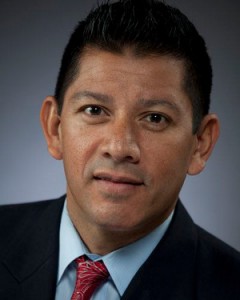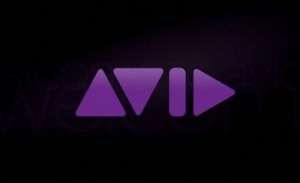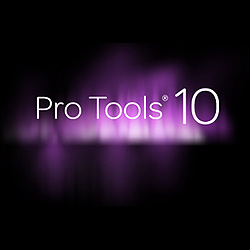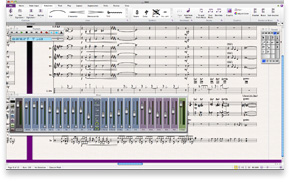Meet the New CEO of Avid: Q&A with Louis Herndandez, Jr. on the Future of Pro Tools
There’s no official President of Pro Audio, but the CEO who runs Avid comes closest to holding that title. Just like the President of the United States is often referred to as the Leader of the Free World, the person who runs the Burlington, MA-based media technology company has responsibilities transcending their job description.
When Avid was founded in 1987, there was nothing to suggest that it would become the steward of the world’s most ubiquitous audio hardware/software systems. At the time, the company was a pioneering creator of nonlinear editing (NLE) systems for film and TV editors – the sound business wasn’t even a twinkle in its eye as it built its digital video editing system, Media Composer, into its own category killer.
But when Avid acquired Digidesign in 1995, audio quickly became a core competency. As everyone knows, Digidesign’s Pro Tools system handily won the DAW war and became the industry standard music production and editing system worldwide, from recording studios to audio post. Its 2006 purchase of Sibelius built on its foundation within the segment via ownership of a top notation software solution in use by composers everywhere. Meanwhile, the M-Audio line has come and gone from Avid’s portfolio.
Overseeing all of this, as of Monday, February 11th, 2013, is a new CEO for Avid: Louis Hernandez, Jr. His installment by the Avid board stands as a welcome chance to begin a new era for the diversified media company, which endured waves of layoffs and a steadily sinking stock price under their former CEO, Gary Greenfield. Consumer confidence in the company has dipped in kind during Greenfield’s five-year-plus term, as everything from poor customer relations to concerns about Avid’s long-term prospects deeply disturbed its audio user base.
Hernandez’ appointment just may provide Pro Tools customers everywhere with reason to hope, however. A longtime board member of Avid, Hernandez became available when the company that he previously headed, the financial technology provider Open Solutions, was acquired this past January at a valuation of $1.15 billion.
While he may be good at generating value for stockholders, Hernandez understands there’s more at stake with his newfound duties. A live music fan and aficionado of the likes of Trombone Shorty, Hernandez stresses early and often that he truly connects with the experience of sound. As the new de facto President of Pro Audio, he’s looking to facilitate the same for a lot of people, far into the future.
Our conversation with Louis Hernandez, Jr., CEO of Avid, follows:
You joined Avid’s board in 2008. What attracted you to the company at the time?
A couple of things. One of them is I’m a technologist. I’ve been in technology and programming since I was a kid – my father taught computer science, actually. My educational background is in finance and economics.
What interested me about Avid is that technology should bring humans closer together, and bring more joy. In this case, someone has the idea of creating content for the enjoyment of another person, and Avid’s role lies somewhere in between there in trying to facilitate that.
I knew Gary when he came onboard, and I knew some of the board members. It was a challenging time – a different time than today. It was pre-Crisis, Avid was doing some different things. During that time, we’ve tried to capture the energy that Avid is known for, and get closer to our customers. We also had a product refresh cycle that we’ve been seeing the fruits of since it started 18 months ago.
Economic activity should be the measure of your value to the community. By that measure, we haven’t added enough value to the community, especially with what our really talented employees can do. I want to rebuild that community, based on how we define what they do: bringing joy to the people that they are trying to reach. That’s why I joined in 2008, and this is where we’re at now.
What were the factors that led to the change of leadership at Avid?
I think Gary felt like he had worked pretty hard to get the company through the crisis, continuing to spend on R&D, which is tough to do when there’s a lot of pressure.
He wanted to bring someone in with a history of growth in technology. I knew a lot of the board members, my company was going to be sold soon, and because we’re friends it was a lot more collaborative transition than would normally be the case. I also was familiar with the strategy, I knew why we did what we did, what worked and hadn’t, and my friendship with Gary made it smoother.
The impetus is to be more squarely focused on growth. The reality is that our market is changing pretty dramatically, so while focusing on the future and growth may sound like a romantic notion, we’re humbled enough to know that the way people create and consume content today is very different, and the value drivers are very different.
I think we’re in the best position to articulate the way you can connect humans with the idea of how they bring pleasure and joy to another person efficiently, economically, and to deliver the value it was intended to bring. Gary and the board wanted someone with that kind of experience tackling those issues in an industry in transition – someone who knows the technology, and with a history of staying connected with communities and inspiring others. That’s what we hope to do here.
How would you characterize Gary Greenfield’s approach to running Avid? In what ways will you stay the course, and what do you expect to do differently?
Gary, as I said, came in at a very different time, so it’s hard to compare. I think he tried to re-establish credible relationships with the clients — that will continue. He tried to refresh the product suite – that will continue. He also established a clear message that we’re focused on the professionals and their market, and that will continue as well.
What will be different is we’ll spend more time focusing on changes in the market, and making sure that Avid reinforces its role as the thought leader. I think we’re in the best position: We created the product category, we’re coming off a big investment cycle in R&D, we have rabid fans, and people on the client and employee side are committed to winning together.
I’m focused on working with the energy of the community, because the challenges are bigger than ever. We want to create a vision of how we enable the most sought-after content, in a more powerful way, and sustain the great joy of creating wonderful music and movies, etc… We’re going to be much more focused on that, rather than realigning products, or achieving cost cuts.
It’s a different time for Avid. This is what I do, and this is why the board asked me to join.
How do you view the opportunities and challenges that characterize the audio portion of Avid’s market today, specifically?
Audio has a long history of lifting the spirits of humans since it’s been recorded. The reason I mention that is because the way it has been created and delivered has changed radically.
I think one of the challenges of audio is that its economic model is under tremendous pressure now, as the consumption of audio-based edited products is rising – it’s just rising in a radically different way than as short as 10 years ago. So your challenge is to work with the community on issues like DRM, and business models that still make money.
Technology can sustain the joy of music, but technology is just the enabler. It can enable the idea coming out of your head into my ears. That’s what humans want – everything else has to be done as efficiently as possible. That’s the great challenge. We’re already a strong leader in audio, we need to continue to be that way, but we need to roll up our sleeves, work with our community, and allow them to do what they want to do, which is create fantastic audio for the enjoyment of other humans.
Despite many bumps for the parent company, the fact is that Pro Tools and its associated I/O hardware has been the industry standard for many years. How did Pro Tools achieve that status, in your opinion, and how do you continue to maintain it?
Pro Tools, I think like its parent Avid in most of the categories in video and audio, can take credit for being the industry standard-bearer, and it started with a group of people who just love what they do for a living. I think the way we sustained it was continuing to have the capital to invest, and continuing to attract people who love this industry, on the client and employee side.
The way we sustain it going forward is to take that energy, and be sure we’re staying relevant to where the industry is going. This highly edited audio content has value, but the way it’s monetized is quite different than 10 or 15 years ago. Our idea is to keep giving you the tools you need to keep doing what you love to do.
That’s how our audio division started, and this is in a way a return to our roots. By recapturing that imagination, I’m hoping we’ll have more people that want to join our community.
On the flipside, are there factors that threaten the ongoing dominance of Pro Tools?
When you create a category, the risk is always that the market shifts on you. Our market has become more fragmented: It’s more of a barbell, with a lot of large players and a bunch of very small players. Also, the way music is created and distributed has changed.
So we have to stay relevant, that’s the bottom line. You stay relevant by making the tools that do things that are strategically important to the users. Yesterday it might have meant laying down 16 tracks and recording it in your studio – tomorrow it could mean doing that in 100 different countries with 1,000 different people.
The way people interact now is different. We intend to stay in front of that, and show people how you can still have the most listened-to music in the world, and other audio output, and deliver that in a very economical way. That’s what we have to keep focused on.
How do you maintain morale at a company that has had annual 10% to 20% workforce reductions? How do you keep these cutbacks from impinging both R&D and customer support?
To build great companies, I think you need two things, and the right personnel will get attracted to you.
The first is to be operationally excellent. We have fantastic people here – we need to give them tools to do their job as well as they’d like to.
The other thing is a conversation on where it’s going. The clearer we make that, the more people want to believe in what’s possible – in our employees and in our client base, we have a lot of believers. I think the more succinctly we can articulate where we’re going, the more energy we’ll have behind our movement. This is a movement that should propagate around the world, and that’s what we’re going to do.
More than one studio owner has told me that they’ve decided to build their new facilities around a different DAW than Pro Tools, based on their lack of confidence in Avid’s long-term prospects. What would you say to them, or others in their position, to prevent future defections?
Well, first of all they should reconsider that and talk to me! (laughs) But look, you can’t get everybody to believe in what you’re doing. I think we’ve worked pretty hard to recapture credibility in the customer base, but it doesn’t mean we’ve gotten to everybody.
I would say Avid created this category, largely. It’s a big player with plenty of capital, and it intends to work closely with our community for a partnership to establish a future for the industry. I would hate to see anybody make a short decision, and then get mad at me because they moved away from our family. Our community is working together to make it better for everybody. Sometimes the family has problems, but you stick with your family.
Last year Avid sold off some major components of its product offerings, including M-Audio and Pinnacle. Is there any chance that Avid would ever sell Pro Tools to another company?
No.
There are many Sibelius users who also are concerned about Sibelius’ status as a priority at Avid. How do you see their concerns, and what would you like to tell them about the future of Sibelius under Avid?
We’re going to stick with our strategy. We have no intention of changing anything – we’re going to stick with Sibelius and the other products in the professional end of the market.
I’m very familiar with the feedback on the changes made at Sibelius. We made changes because we love that product and category. We made changes to have a sustainable long-term model. A critical component of our strategy is to deliver what our clients want. I’m very anxious to work with that group. I’ve learned that if we work together good things can happen, and that’s what we hope to do.
Lastly, where do you hope to take Avid’s audio business in the years to come? What is the ideal scenario, and how do you plan to ensure that takes shape?
Audio, which is largely already a standard, becomes the de facto standard for any creative audio user in the world. It’s a simple goal: I want everyone in the world using the best products, which I believe Avid has.
To do that, to lead it, we have to keep our partners happy – that’s our clients. We have to stay strategically relevant in a dynamic market putting them under tremendous pressure. And we have to build a tighter community. We have to have this feeling that we’re all doing this together as one.
That’s easier said than done, but if we do that, I have no question the only product or service you’d want to use anywhere in the world, in any language, is the Avid suite.
Is there anything else you’d like to add?
We’re proud of our heritage and of the investment we’ve made. We have a lot more to do. But more importantly, this should mark a new phase for Avid, one focused on growth and building a strong community. Hopefully if we do that we’ll be fine, and get more people to see what we’re trying to do.
— David Weiss
Please note: When you buy products through links on this page, we may earn an affiliate commission.











rdill
February 19, 2013 at 7:05 am (12 years ago)Sibelius Users would certainly disagree with the comments made above regarding the programme. The Avid take over has been a disaster.
Derek Williams
February 19, 2013 at 5:32 pm (12 years ago)All platitudes. Neither Mr Hernandez nor his predecessor nor anyone else has ever been able to explain in simple, logical terms, the commercial wisdom in sacking the developers of Sibelius, the world’s best selling music scoring applicatiion, leading to their re-employment by the industry giant Yamaha to create a hot competitor for Sibelius.
With that rationale, the Avid board should sack themselves and also seek employment at Yamaha.
Derek Williams
danwriter
February 21, 2013 at 5:39 pm (12 years ago)David: Good piece.
eldred
December 8, 2014 at 5:34 pm (10 years ago)empty corporate blabber
Jonah Christian
January 3, 2015 at 11:13 am (10 years ago)Dear Avid,
How come Pro Tools 11 is so buggy? Why does a company with millions, maybe billions of dollars neglect its user base so much? How does a company that makes the claim to be “the world’s leading provider of audio and video technology”, have such a difficult time in clearing up bugs that seem to remain and haunt and plague it’s software, version to version? Take a company like Apple Computer for instance, who acquired E-magic and their software, Logic years ago. Apple seemingly ignores development of Logic (no updates since 10.0.7 in over 6 months), and yet the platform is at least twice as stable as Pro Tools 11.3. How can this be? I wanted to take the time to write this letter because I am extremely frustrated. Your company has such stringent policies in regards to adhering to specific specifications to maintain compatibility, and yet when they are followed to the letter your software is still buggy. For example, I am running a late 2013 27″ iMac, model identifier: 14,2, which falls into your “qualified models” category. It is a Core i7 3.5 GHz with 32 GB of RAM running OS X 10.10.1 Yosemite and Pro Tools 11.3. I am not running any 3rd party plugins whatsoever, and yet I still have consistent bugs that inhibit me from being productive. So see, even when trying to eliminate all variables based on your companies own guidelines, myself and I believe many others still have major issues with the stability of Pro Tools. I certainly hope this letter does not fall on deaf ears, as I plan to share it with as many people and on as many social networks that I can. I will close by pasting in links to my last two threads on your forum. I sincerely hope things change soon. I will have to say that I don’t hold much hope for that though, seeing as I have been a Pro Tools user for well over 10 years now and things remain pretty much the same, unstable…
Sincerely,
A frustrated and disgusted Pro Tools user
Links to my current threads:
http://duc.avid.com/showthread.php?t=362635
http://duc.avid.com/showthread.php?t=362632